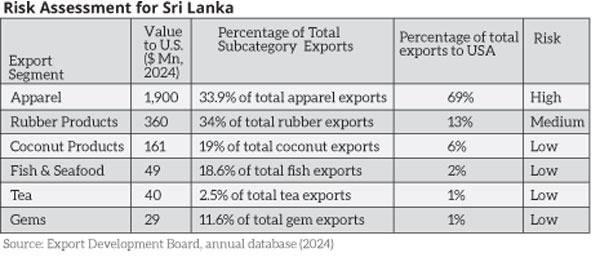LNP – USA Tariff slap – Significant risk to SL economy
- Sri Lanka is heavily reliant on exports to the U.S., with approximately 23% of its total exports destined for the American market
- The imposition of a 44% tariff on Sri Lankan goods by the U.S. poses significant risks to Sri Lanka’s economy, particularly its apparel industry
- More diversified portfolio of tea, precious stones, fish and seafood are less affected due to their smaller share in total exports to the U.S.
- By diversifying its export markets and adapting to changing trade and Asian consumer dynamics, Sri Lanka can mitigate risks and explore new avenues for economic development.
- It is safe to say that President Donald Trump has been influenced by Hamilton’s ideas, particularly in his dealings with all its trading partners (including developing countries), where he has sought to reduce the U.S. trade deficit through tariffs and other trade restrictions
By Dr. Kenneth De Zilva
The United States yesterday announced and introduced a significant shift in its trade policy by imposing tariffs on imports, marking a departure from the globalization and comparative advantage doctrine that has dominated international trade for decades. This move aims to revert to a more national (i.e. MAGA, or Make America Great Again) and protectionist model, reminiscent of Alexander Hamilton’s economic strategy, which emphasizes domestic manufacturing and economic self-sufficiency. It is safe to say that President Donald Trump has been influenced by Hamilton’s ideas, particularly in his dealings with all its trading partners (including developing countries), where he has sought to reduce the U.S. trade deficit through tariffs and other trade restrictions.
Reversing Globalization and Twin Deficits
This neo-Hamiltonian pivot reflects a consensus that neoliberal globalization failed to constrain China’s state-driven model. Globalization has led to the outsourcing of manufacturing and substantial trade deficits for the U.S. The new policy seeks to reverse this trend by extracting surpluses from major trading partners like the EU and Asia. President Trump’s approach introduces a new economic focus, prioritizing a balanced trade ledger and domestic economic growth. This strategy is designed to address the failures of globalization in reducing economic disparities and promoting equitable growth.
Economists Critique of Globalization
Economists like Joseph Stiglitz have long argued that globalization has exacerbated income inequality and failed to address poverty effectively. In his book “Globalization and Its Discontents,” Stiglitz critiques the role of multilateral agencies such as the IMF and World Bank in perpetuating these issues. Jeffrey Sachs too has also highlighted the flaws in the multilateral agenda, emphasizing the need for more equitable and sustainable economic policies.
Impact on Sri Lanka
Sri Lanka is heavily reliant on exports to the U.S., with approximately 23% of its total exports destined for the American market, of which 55% is apparel sector related exports. In 2024, Sri Lanka’s exports to the U.S. included significant contributions from multiple sectors, namely, from the apparel, rubber, coconut, tea, gems, and fish sectors.
Risk Assessment for Sri Lanka
The imposition of a 44% tariff on Sri Lankan goods by the U.S. poses significant risks to Sri Lanka’s economy, particularly its apparel industry. Here is a risk assessment table highlighting the potential impacts of the U.S. tariffs on Sri Lanka’s exports:

Explanation of Risk Ratings:
High: The apparel sector is highly vulnerable due to its significant contribution to Sri Lanka’s exports to the U.S. and the potential for sharp declines in orders due to increased costs, will have significant impact on an industry that accounts for 710,000 direct and indirect jobs.
Medium: Rubber products face moderate risk as they are less sensitive to price changes compared to apparel but still contribute substantially to exports while employing 400,000 both direct and indirect.
Low: More diversified portfolio of Tea, precious stones, and fish & seafood are less affected due to their smaller share in total exports to the U.S. and potentially less price-sensitive markets.
Final Thoughts
The U.S.’s new tariff policy reflects a broader shift away from globalization and towards economic nationalism and national balance sheet economic model approach. While this presents challenges for the global economy and countries like Sri Lanka, it also offers opportunities for strategic diversification and seeking new growth partners (BRICS plus is one such block), as the trade landscape has been leveled out. The high tariffs imposed on Sri Lanka’s merchandise exports, particularly in the apparel sector, pose significant risks to the country’s economy and employment. However, by diversifying its export markets and adapting to changing trade and Asian consumer dynamics, Sri Lanka can mitigate these risks and explore new avenues for economic development.
Dr. Kenneth De Zilva is a Business Cycle Economist

